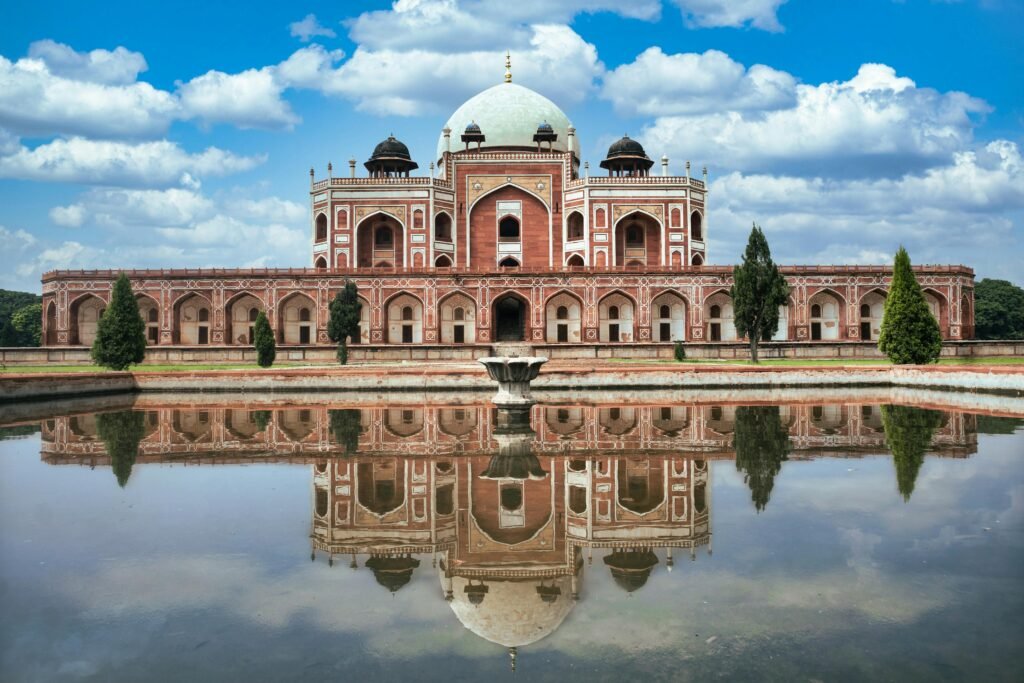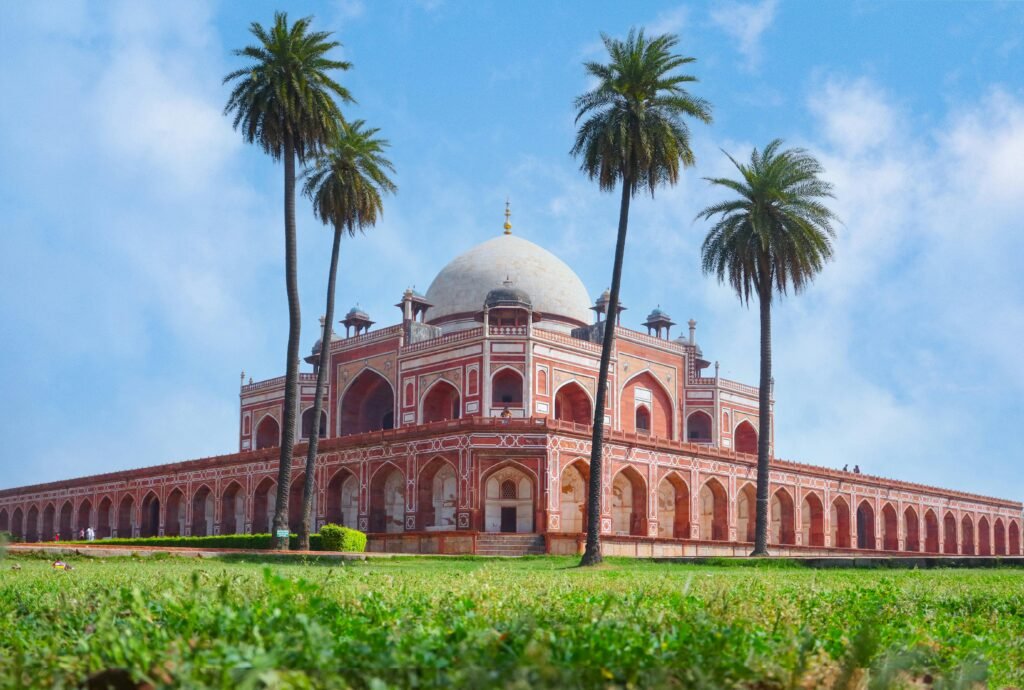The magnificent Mughal architecture and the lasting influence of its time are exemplified by Humayun’s Tomb, an architectural wonder located in the centre of Delhi, India. Constructed between 1565 and 1572, this UNESCO World Heritage Site is more than just a mausoleum; it’s a representation of the Mughal Empire’s magnificence and a significant forerunner to the Taj Mahal. We explore this amazing structure’s history, architectural significance, cultural impact, and conservation in this blog.
Historical Context
The Mughal Emperor Humayun’s widow, Empress Hamida Banu Begum, ordered the construction of Humayun’s Tomb. Following Humayun’s demise in 1556, his widow sought to pay tribute to her spouse by erecting a stately mausoleum that would symbolise both her husband’s position and the Mughal Empire’s emerging architectural capabilities. Under the supervision of Hamida Banu Begum, the Persian architect Mirak Mirza Ghiyas created the mausoleum. Given the Mughal Empire’s ties to Persia and its impact on Mughal architectural traditions, the selection of a Persian architect was noteworthy.
Architectural Design and Structure
The inventive architectural style of Humayun’s Tomb is frequently praised for being a major break from the conventional Indian tomb constructions of the era. It is among the first structures to exhibit Mughal architecture, displaying elements that would eventually be improved upon in the building of the Taj Mahal.
Layout and Aesthetics
The Charbagh (four gardens) pattern, in which the mausoleum is situated, represents the Islamic idea of heaven. The design consists of a square garden with water channels that symbolise the rivers of paradise dividing it into four main sections. The garden itself is a carefully designed space with water features, lush vegetation, and paths that all work together to create a calm and harmonious atmosphere.
The mausoleum is raised on a tall platform and is situated in the middle of the garden. It is built of red sandstone and features beautiful white marble inlays that contrast dramatically. One of the tomb’s most remarkable characteristics is its dome, which stands 47 meters (154 feet) high and is decorated with an elaborate finial. The tomb’s grandeur is enhanced by a sequence of smaller domed constructions surrounding the dome, which is supported by a network of arched corridors.
Architectural Innovations
The usage of double-domed architecture in Humayun’s Tomb is among the most noteworthy architectural innovations. The structure’s weight is distributed more evenly thanks to the larger outer dome that rests atop the smaller inner dome. This method not only improves the tomb’s stability but also produces an amazing visual effect.
The elaborate tile work and ornamental carvings on the tomb provide as more evidence of the high level of craftsmanship at that period. The structure’s aesthetic appeal and spiritual importance are enhanced by the use of geometric designs, floral motifs, and Quranic calligraphic inscriptions.

Table of Contents
Cultural and Historical Significance
Humayun’s Tomb holds a significant place in the history of the Mughal Empire, serving as a precursor to later Mughal architectural masterpieces. It represents a crucial transition in Mughal architecture from the traditional Indian styles to the more elaborate Mughal designs that would come to define the empire’s architectural legacy.
Influence on Mughal Architecture
Humayun’s Tomb established the standard for later Mughal tombs and palaces; the tomb’s emphasis on symmetry, intricate ornamentation, and use of white marble became hallmarks of Mughal architecture; the tomb’s architectural elements—such as the Charbagh layout and double-domed construction—were later employed in the design of the Taj Mahal.
Symbol of Mughal Legacy
The tomb also represents the Mughal Empire’s lasting influence and the period’s exceptional architectural design. It is a monument to the artistic and cultural accomplishments of the empire, capturing the magnificence and refinement of Mughal governance. The tomb has evolved into a globally recognised emblem of Delhi’s historical and cultural legacy, drawing tourists from all over the world who come to take in its breathtaking beauty and discover its past.
























Conservation and Restoration Efforts
In order to maintain its historical and architectural integrity, Humayun’s Tomb has undergone multiple phases of conservation and restoration over the ages. The tomb has had to contend with a number of issues, such as deteriorating environmental conditions, urban expansion, and the passage of time.
Early Restoration Efforts
When the British colonial authorities realised how important the tomb was historically, they repaired it to stabilise the structure and maintain its original features. The first major restoration work started in the late 19th and early 20th centuries, addressing the damage caused by neglect and natural wear.
The Aga Khan Trust for Culture
The Aga Khan Trust for Culture (AKTC) started a significant conservation project in the early 2000s, completely restoring the mausoleum and the surrounding grounds. The project’s goal was to return the mausoleum to its former splendour while making sure that cutting-edge conservation methods were used to shield it from harm in the future.
Repairing the intricate tile work, stabilising the walls and dome, and rearranging the Charbagh garden’s layout were all part of the restoration process. The project also focused on enhancing the surrounding infrastructure to enhance the visiting experience and assure the tomb’s long-term preservation.
Visiting Humayun’s Tomb
For those interested in Mughal history and architecture, Humayun’s Tomb is a must-visit location and a well-liked tourist destination today. Visitors can discover the elegance of Mughal architecture and take in the peace of the Charbagh gardens at this location.
Visitor Experience
The large gardens that encircle the tomb welcome guests as soon as they arrive. The main mausoleum, where the magnificence of Mughal architecture is completely displayed, is reached via the paths. A look into the splendour of Mughal architecture can be seen in the tomb’s interior, which is decorated with exquisite carvings and marble inlays.
The complex’s other smaller buildings and tombs, some of which house the remains of former Mughal emperors and nobles, are also open for exploration by guests. The location offers a calm and contemplative setting that enables guests to understand the tomb’s architectural and historical significance.
Practical Information
The tomb is reachable from a number of locations in Delhi, and guided tours are offered to individuals who wish to learn more about its background and importance. Specific hours and admission costs are subject to change, so it’s best to confirm the most recent details before making travel arrangements.
Conclusion
More than merely a mausoleum, Humayun’s Tomb is a colossal representation of Mughal architectural creativity and cultural legacy. Its historical significance, design, and preservation efforts emphasise how important it is to comprehend and value historical sites. You are not only seeing a piece of history as you tour the mausoleum and its gardens; you are also taking in the enduring splendour and beauty of Mughal architecture.












